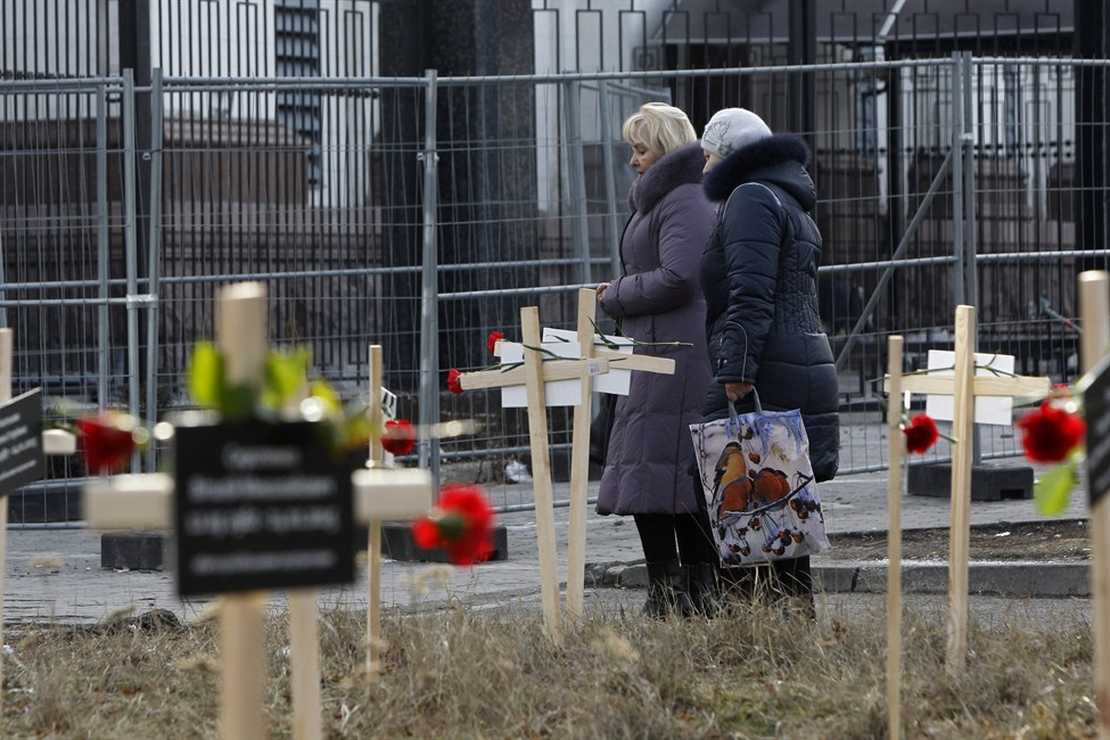
It was a week ago today that Russia bombed Mariupol’s maternity hospital, part of a plan to shell and starve the residents into surrendering. The city has been without food, water, and power for weeks as the Russian siege grinds on.
One week later, a new atrocity:
Horrifying reports that Mariupol’s drama theater was bombed today in a Russian airstrike. Hundreds of civilians were reportedly sheltering inside, according to Mariupol’s city council.
The building is located in a park in the city center. Impossible that this was an accident.
— Nolan Peterson (@nolanwpeterson) March 16, 2022
There’s no confirmation yet of how many people were inside, as it’s too dangerous for rescue teams to venture out amid the bombing and dig through the rubble. But reports on social media are widespread that it was being used by a huge number of civilians as a shelter. Here are the before and after shots of the building:
Day 21: Russian strategically void and morally bankrupt invasion of #Ukraine continues. The just bombed the famous Drama theater in #Mariupol. Over a 1000 people were taking shelter in this building. So this might have been a terrible disaster. #PrayingForUkraine 😱🥲💙💛🇺🇦 pic.twitter.com/AGzpFhSKsw
— Artists4Ukraine 🇺🇦 (@Artists4Ukraine) March 16, 2022
Multiple reports that Russian forces dropped a bomb on Mariupol drama theatre where (at least until yesterday) hundreds of people were taking refuge. If confirmed refugees were still inside, this would be potentially the worst civilian harm incident and an undisputable war crime. pic.twitter.com/sDfhHULLCM
— Christo Grozev (@christogrozev) March 16, 2022
There’s hope that many survived, as apparently there was a bomb shelter in the theater’s basement. Maybe the impact wrecked the standing structure but not the bunker underneath. But even in that best-case scenario, they might be trapped with no hope of near-term rescue:
In an announcement the Mariupol mayor suggests that this theatre had a bomb shelter
Civilians were—hopefully—taking cover there, but the mayor claims the shelter’s entrance was destroyed along with the theatre. If there are survivors, retrieving them may not be simple. Horrid https://t.co/eR6Lp6ynTR
— Richard Ensor (@richardjensor) March 16, 2022
I wonder what excuse we’ll be given this time for why Russia would target a structure as innocuous as a theater. The excuse last week was that the maternity hospital was supposedly being used as a staging area by a Ukrainian militia. When photos showed pregnant women being carted out on stretchers in the aftermath, Russian propagandists resorted to claiming that they were crisis actors. My guess is we’ll be told the theater was a weapons depot.
READ RELATED: College Instructor ‘Sweetheart’ Mows Down Cop-Boyfriend – Crime Online
A few hours ago I wrote that if it’s true that the two sides are moving towards a peace deal, especially one that’s humiliating for Russia in some degree, we’d expect the Russian military to turn more ruthless to try to maximize Putin’s leverage. The theater bombing is an example.
The killing in Ukraine might — might — stop sooner rather than later but in Russia it may be poised to accelerate. Numerous observers flagged this bit from a new Putin speech today for its classically fascist rhetoric, a sign that whatever’s next for Russians after this war won’t be good:
Ominous words from Putin about a “natural and necessary cleansing of the nation” to “spit out like flies” all representatives of a fifth column and “traitors” who do not back the Kremlin line. No wonder thousands are leaving the country in fear. pic.twitter.com/66LGpo12p3
— Matthew Luxmoore (@mjluxmoore) March 16, 2022
Back in Mariupol, two Associated Press reporters have been inside the city from the beginning watching it fall into chaos as Russia tightens the noose. Putin wants the city so that he can create a corridor along Ukraine’s southern border from the Donbas in the east to Crimea in the south. Mariupol won’t capitulate, though. And so the slaughter is on:
There’s 18-month-old Kirill, whose shrapnel wound to the head proved too much for his little toddler’s body. There’s 16-year-old Iliya, whose legs were blown up in an explosion during a soccer game at a school field. There’s the girl no older than 6 who wore the pajamas with cartoon unicorns, among the first of Mariupol’s children to die from a Russian shell.
They are stacked together with dozens of others in this mass grave on the outskirts of the city. A man covered in a bright blue tarp, weighed down by stones at the crumbling curb. A woman wrapped in a red and gold bedsheet, her legs neatly bound at the ankles with a scrap of white fabric. Workers toss the bodies in as fast as they can, because the less time they spend in the open, the better their own chances of survival…
Many of the deaths documented by the AP were of children and mothers, despite Russia’s claims that civilians haven’t been attacked. Doctors say they are treating 10 civilians for every injured Ukrainian soldier.
Estimates place the death toll at 2,500 but that’s a guess because the bodies can’t be reliably counted while intense shelling is going on. Put it this way, though: Per the AP, there are so many corpses that families are being told to leave the dead outside their homes for collection, as funerals are impossible at the moment.
Ed wrote earlier about Mykolaiv, another southern city that Russia covets because it’s the potential staging area for an assault on Odessa. Siege conditions there are also horrendous:
Alla Ryabko stood in the courtyard of the city morgue, trembling with grief and rage. Her son, Capt. Roman Ryabko, had been killed in fighting on the first day of the war in Ukraine, but two weeks had passed and his body had not yet been prepared for burial.
“He’s there lying in a bag,” she said, gesturing to the covered bodies on the ground. “They’re not even giving him to me so that I can wash him. I have to take him away in a bag, a garbage bag.”
The morgue is overflowing. Bodies are being released to families in the state they arrived, half-dressed in shredded military uniforms, spackled with blood and blackened by fire. Bodies are in the corridor, in the administrative offices, in the courtyard, in a storage shed nearby. They are soldiers and civilians, wrapped in sheets or carpets or nothing at all.
Even so, hatred of the Russians is such that the city’s residents are doing their best not to succumb to the intended demoralization: “Trash is still being collected, and city workers have embarked on an aggressive tree-pruning campaign, though the shelling is knocking down some of those trees.”
In fact, for a taste of how hard it’s been for Russian troops to intimidate the Ukrainians, read this stirring account of the defense of Voznesensk, a small city to the northwest of Mykolaiv. Russia advanced on Voznesensk two weeks ago, hoping to secure it as an alternate route into Odessa to the west. The residents blew up the bridge to slow their advance, then killed 100 Russian troops and took three-quarters of their military vehicles during a two-day battle. The Russians ended up pulling out and retreating 40 miles to the southeast, where they came under further attack from Ukrainian troops there. Nothing’s easy for Putin in occupied Ukraine.
Source:






